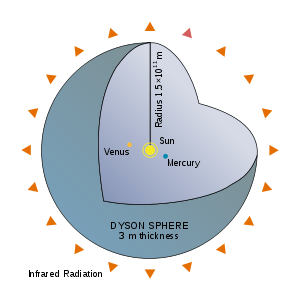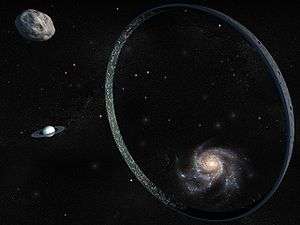Astroengineering
Astroengineering is engineering at astronomical scale, i.e. at planetary, stellar, stellar system, galactic or even larger scale. It is a form of megascale engineering. An example is the hypothetical Dyson sphere.
Applications
Typical megastructures that could hypothetically be produced by astroengineering include Dyson spheres, ringworlds, Alderson disks, Banks' Orbitals, Matrioshka brains, stellar engines such as Shkadov thrusters, and other artifacts produced by Type II and Type III civilizations on the Kardashev scale.
In a 2005 paper, Luc Arnold proposed a means of detecting smaller, though still megascale, artifacts from their distinctive transit light curve signature.[1]
Some applications are becoming more relevant to our time period as advances in technology progress. Astroengineering projects like orbital towers (or orbital elevators) are becoming more technically feasible due to such technological advances.[2]
It was suggested that an advanced civilization could use a pulsar for signalling through the modulation of its light curve.[3] Such an application would require construction of a large scale structure (modulator) around the pulsar. Possible observable effects are missing pulses and an increase in thermal radiation due to the secondary emission from the modulator. Missing pulses (pulse nulling) has been observed in many pulsars and is usually attributed to natural phenomena.[4] However, a statistical study of the missing pulse sequences revealed that nulling is not random in many pulsars.[5] This poses a problem of distinguishing the natural modulation from artificial one.
Changing the cycle parameters of variable stars (Cepheids) is theoretically possible by firing a high-energy neutrino beam into the star's core. This effect can be used as a way to transmit information and create "galactic Internet".[6][7] The rate of transmission is very slow, though, about 180 bits per year.
Limiting factors
Resources is the one of the limiting factors preventing advances in astroengineering. Since astroengineering revolves around creating megastructures that could be millions of kilometers long, obtaining materials would require more than Earth's resources.
Even if resources become more abundant from other planets and planetary systems, energy limits what engineers would be able to accomplish. Creating large-scale structures requires large amounts of energy. Potential energy sources which would be used by a Type II or Type III civilization on the Kardashev scale include:
- A Dyson sphere or Dyson swarm and similar constructs are hypothetical megastructures originally described by Freeman Dyson as a system of orbiting solar power satellites meant to enclose a star completely and capture most or all of its energy output.[8]
- Perhaps a more exotic means to generate usable energy would be to feed a stellar mass into a black hole, and collect photons emitted by the accretion disc.[9][10] Less exotic would be simply to capture photons already escaping from the accretion disc, reducing a black hole's angular momentum; known as the Penrose process.
- Star lifting is a process where an advanced civilization could remove a substantial portion of a star's matter in a controlled manner for other uses.
- Antimatter is likely to be produced as an industrial byproduct of a number of megascale engineering processes (such as the aforementioned star lifting) and therefore could be recycled.
- In multiple-star systems of a sufficiently large number of stars, absorbing a small but significant fraction of the output of each individual star.
- White holes, if they exist, theoretically could provide large amounts of energy from collecting the matter propelling outwards.
- Capturing the energy of gamma-ray bursts is another theoretically possible power source for a highly advanced civilization.
- Type III civilizations might use the same techniques employed by a Type II civilization, but applied to all possible stars of one or more galaxies individually.[11]
- They may also be able to tap into the energy released from the supermassive black holes which are believed to exist at the center of most galaxies.
- The emissions from quasars can be readily compared to those of small active galaxies and could provide a massive power source if collectable.
In fiction
Astroengineering has been described in many works of fiction:
- In the Ringworld series by Larry Niven, a ring a million miles wide is built and spun (for gravity) around a star roughly one astronomical unit away. The ring can be viewed as a functional version of a Dyson sphere with the interior surface area of 3 million Earth-sized planets. Because it is only a partial Dyson sphere, it can be viewed as an intermediary between Type I and Type II. Both Dyson spheres and the Ringworld suffer from gravitational instability, however—a major focus of the Ringworld series is coping with this instability in the face of partial collapse of the Ringworld civilization.
- Stephen Baxter's "Morlock" of The Time Ships occupy a spherical shell around the sun the diameter of earth's orbit, spinning for gravity along one band. The shell's inner surface along this band is inhabited by cultures in many lower stages of development, while the K II Morlock civilization uses the entire structure for power and computation.
- In the Star Trek: The Next Generation episode "Relics", the Enterprise discovers an abandoned Dyson sphere.[12]
- In the Halo universe, The Forerunners created many planet-sized artificial megastructures, such as the Halo ringworlds, the 2 Arks and the Shield Worlds, which were micro - Dyson Spheres. One of the Precursor's most well known creations were the Star Roads. Immense, indestructible cables that connected planets and star systems.
- In the movie Elysium (film) a large scale space habitat has been built to orbit Earth and is capable of sustaining life permanently.
- In the Corellian Trilogy (Star Wars extended universe books), the Corellian system is revealed to have been constructed by an unknown ancient civilization, using Centerpoint Station to transport the planets across interstellar distances, and "planetary repulsors" to maneuver the planets into their orbits.
Gallery
-

A cut-away diagram of an idealized Dyson shell, a variant on Dyson's original concept, with a radius of 1 AU.
-

Orbital illustration, with no apparent Hub.
-

A schematic illustration of an Alderson disk.
-

A proposed plan for an orbital ring.
See also
References
- ↑ Arnold, Luc F. A. (2005). "Transit Light‐Curve Signatures of Artificial Objects" (PDF). The Astrophysical Journal. 627: 534–539. doi:10.1086/430437. Retrieved January 6, 2009.

- ↑ Colin R., McInnes (March–April 2005). "Dynamics of a particle moving along an orbital tower" (PDF). Journal of Guidance, Control and Dynamics. 28 (2): 380–382. ISSN 0731-5090.
The concept of an orbital tower has been discussed in the literature by many authors over a number of years. Although the concept is clearly futuristic, interest has recently been revived as a result of advances in materials science.
- ↑ Chennamangalam, Jayanth; Siemion, Andrew P.V.; Lorimer, D.R.; Werthimer, Dan (January 2015). "Jumping the energetics queue: Modulation of pulsar signals by extraterrestrial civilizations". New Astronomy. 34: 245–249. doi:10.1016/j.newast.2014.07.011.
- ↑ Wang, N.; Manchester, R. N.; Johnston, S. (21 May 2007). "Pulsar nulling and mode changing". Monthly Notices of the Royal Astronomical Society. 377 (3): 1383–1392. doi:10.1111/j.1365-2966.2007.11703.x.
- ↑ Redman, Stephen L.; Rankin, Joanna M. (21 May 2009). "On the randomness of pulsar nulls". Monthly Notices of the Royal Astronomical Society. 395 (3): 1529–1532. doi:10.1111/j.1365-2966.2009.14632.x.
- ↑ Choi, Charles (9 September 2008). "'Galactic internet' proposed". Nature. doi:10.1038/news.2008.1091.
- ↑ http://arxiv.org/abs/0809.0339v2
- ↑ Dyson, Freeman J. (1966). Marshak, R. E., ed. "The Search for Extraterrestrial Technology". Perspectives in Modern Physics. New York: John Wiley & Sons.
- ↑ Newman, Phil (2001-10-22). "New Energy Source "Wrings" Power from Black Hole Spin". NASA. Archived from the original on 2008-02-09. Retrieved 2008-02-19.
- ↑ Schutz, Bernard F. (1985). A First Course in General Relativity. New York: Cambridge University Press. pp. 304, 305. ISBN 0-521-27703-5.
- ↑ Kardashev, Nikolai. "On the Inevitability and the Possible Structures of Supercivilizations", The search for extraterrestrial life: Recent developments; Proceedings of the Symposium, Boston, MA, June 18–21, 1984 (A86-38126 17-88). Dordrecht, D. Reidel Publishing Co., 1985, p. 497–504.
- ↑ "Star Trek: The Next Generation Relics (TV episode 1992) - IMDb". IMDB. Retrieved 2011-11-21.
Further reading
- Korycansky, D. G.; Laughlin, Gregory; Adams, Fred C. (2001). "Astronomical engineering: a strategy for modifying planetary orbits". Astrophysics and Space Science. 275: 349. doi:10.1023/A:1002790227314. Astrophys.Space Sci.275:349-366,2001.
- " Astronomical Engineering Revisited: Planetary Orbit Modification Using Solar Radiation Pressure", Astrophysics and Space Science, Volume 282, Number 4, 765-772, doi:10.1023/A:1021178603836